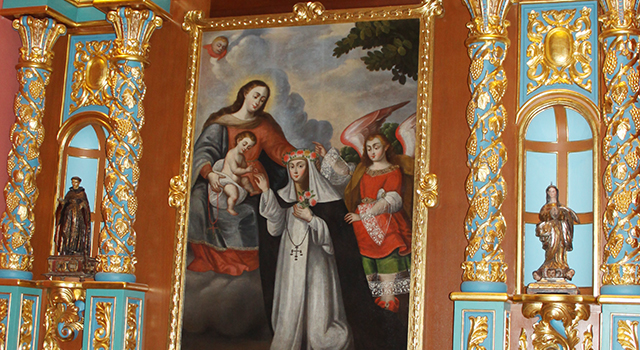By Rocio Granados - La Voz Catolica
MIAMI | Impressed by the colonial and architectural art of Santa Maria Magdalena Catholic Church in Lima, Peru, Father José Luis Menéndez, pastor of Corpus Christi Catholic Church in Miami, got the idea of creating a cultural legacy for Peruvian immigrants in South Florida.
Over 12 years ago the priest of Cuban origin traveled to Lima, Peru, to work with the Hermandad del Señor de los Milagros (Brotherhood of the Lord of Miracles), a deeply rooted devotion from that country which spread to South Florida with the arrival of Peruvian immigrants.
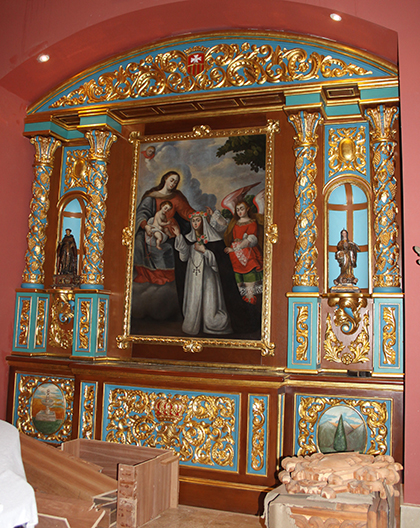
Photographer: ROCIO GRANADOS | LVC
Paint of Santa Rosa de Lima, the Peruvian saint, belongs to the school of painting Cuzqueña, arose in Peru in the time of the Viceroy. The image is placed on one of the small altars already with gold lamination.
During his trip, he visited a church that may not look very attractive on the outside. Inside, however, he was struck by the colonial art and the decoration with works by the Painting School from Cuzco, which emerged in Peru in colonial times, and altars carved in wood and bathed in gold.
The priest recalled that as he entered the church, built in 1557, he thought, "If we had this in Miami... It is not an old church, no! Look at this palace!"
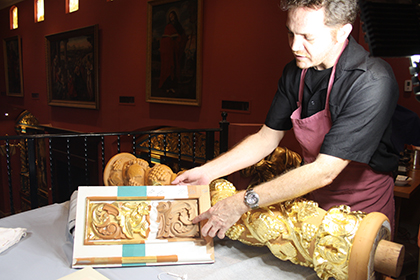
Photographer: ROCIO GRANADOS | LVC
Ulises Acosta explains the preparation process of the wood to place the gold lamination. Acosta is one of the three specialists who are placing the gold leaf on the altars of the La Merced Church-Museum, located at Corpus Christi Church in Miami.
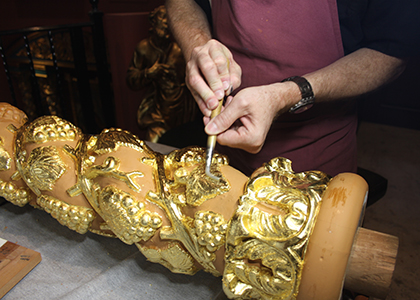
Photographer: ROCIO GRANADOS | LVC
Ulises Acosta shows how the gold foil is placed on a column of carved cedar wood. Acosta is one of the three specialists who are placing the gold leaf on the altars of the La Merced Church-Museum, located at Corpus Christi Church in Miami.
When he returned to Miami, he wanted to bring to the United States a little bit of that richness so Hispanics could leave a legacy in the country that welcomed us all.
"Hispanics do not think about legacy," lamented Father Menéndez.
The Cuban community is the most prominent in this part of the country. "They will leave the Shrine of Our Lady of Charity,” he thought. “So, what have the Peruvians made in Miami…?”
That is how the idea of building the Peru Church-Museum was born. Construction began more than 11 years ago on the grounds of the parish of Corpus Christi. At the beginning, most of the structure was built with the collaboration of the parish Peruvian community. However, it was a very ambitious project and they had to ask for help from other parish communities. What began as the Peru Church-Museum became the Church of La Merced.
The church, still unfinished, has paintings, sculptures and historical documents. "It houses the largest collection of colonial paintings in the United States. When it is finished we will have the most beautiful, colonial, baroque church in the United States," stated the Cuban priest.
The lamination
Since 2013, concerts and other cultural activities have taken place at the church.
Originally, they thought of varnishing the altars only: the main altar and four small ones, all carved by hand in cedar wood by Bolivian master craftsmen who recreated the baroque period in South America between the 17th and 18th centuries.
Then, in February 2015, three Cuban specialists began the gold lamination of the altars with the polychrome technique.
Laminating every small altar took about four months.
"Initially there were pieces where the varnish had to be removed. The wood was saturated because it absorbed several layers of resin oil, and it got more complicated when it came to applying the water based treatment (for lamination)," explained Alexis Caser, a gold foil expert.
Now they are working on the high altar. They are considering an ocher-colored background for the columns, "to give them greater shine so it can look brighter than the small altars, because the most important pieces, the religious images with the highest value within the church are going to be there," said Ulises Acosta, a specialist in gold leafing.
Real gold laminate achieves a beauty not obtained with imitation gold or other inexpensive techniques. The gold leaf used is 23 karat gold.
"The problem with pretty viceregal churches is that they are made with expensive beauty," noted Father Menéndez. "We are doing this to last 300 years. We are working to leave a legacy."
"Gold is a very noble metal; it does not rust and if the work of conservation and preservation is good, it will last many years," confirmed Acosta.
The process
The technique for applying gold leaf is using traditional gold with natural products. It begins by placing an organic glue on the wood, which creates a film that will grab the other layers of preparation.
"The preparation base helps to keep the gold brilliance and the whole base will not come off when the gold is applied and polished," explained Acosta. Then it is covered with Armenian bole and the laminate begins, “slowly placing the sheets of gold to cover the surface to be laminated, in this case, the relief of the wood. The background is left flat, without lamination, so you can give the depth effects with color," explained Acosta.
The sheets of gold are glued with an adhesive that is "always warm, so it softens the previous steps that the piece to be gilded had. You take the grease from its face and stick the sheet," said Elizabeth Campillo, a gold laminate expert.
When the gold is glued, it must be buffed with special stones. "These bring brilliance to the metal; it is rubbed to get the desired effect. The finish is a very tedious process," said Acosta, who along with Campillo and Caser worked in the conservation and restoration of cultural heritage in the Oficina del Historiador de La Habana (Office of the Historian of Havana) in Cuba.
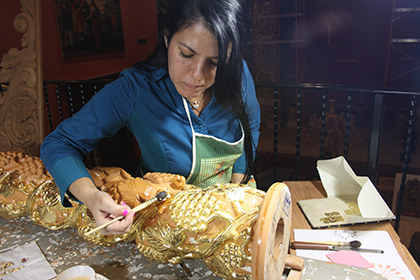
Photographer: ROCIO GRANADOS | LVC
Elizabeth Campillo, a gold laminate specialist placed a gold foil in a column of carved cedar wood. Campillo from Cuba worked in the conservation and restoration of cultural heritage in the Oficina del Historiador de La Habana (Office of the Historian of Havana) in Cuba.
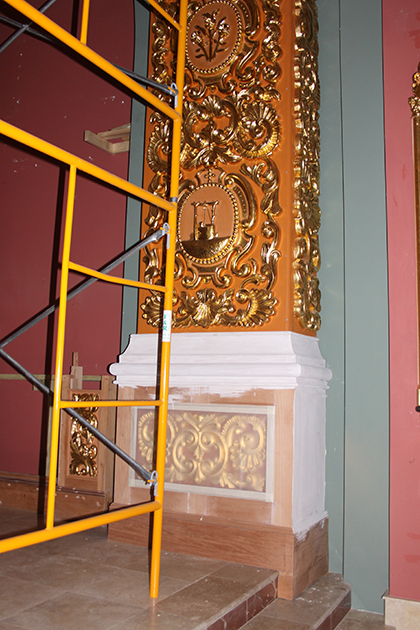
Photographer: ROCIO GRANADOS | LVC
Part of the main altar with gold leaf of the La Merced Church-Museum, at Corpus Christi Church in Miami.
Campillo and Acosta learned the gold-rolling technique from Caser when they arrived in Miami and began the project at the Church-Museum.
Caser studied at the Instituto Superior de Arte (University of Arts) in Cuba, and obtained a degree in Conservation and Restoration of Museum Artifacts. Then he worked in the Office of the Historian of Havana and knew Warsaw, Krakow and the Prado Museum in Spain through his work.
He worked restoring pieces, paper documents, and canvases in Havana. That is how he met a person who told him that they would value his work in the United States, and when he arrived in Miami he put him in touch with the church of Corpus Christi.
"We had no idea about this project. We have been learning about it with Father Menéndez and Ray Zamora (project director for the Museum)," said Caser. The important thing about this project is that "here in Miami this type of church is very atypical. Churches are very sober, empty, like very cold," he added.
The greatness of the gold laminate is because it is not in use today. "Churches and chapels are built with modern materials and techniques. This one recreates here in the United States the Latin American baroque period. I think it is the only church with these features in the United States, and would show Americans what we have in our Latin American countries”.Also, “it is something that would become
Also, “it is something that would become patrimony of this nation", indicated Acosta.
"The square where the church is located should be named Plaza America," suggested Caser.
Although the ceiling is going to keep the wood color, lamps still need laminate. They will work on the entrance doors and change the frames of the works of art that will remain, to assure uniformity. The coating will be finished in two years, perhaps a little longer.
To coat the church is very costly. Until now those who have helped "have been the humble people, the devotees of the Lord of Miracles, but a million and a half dollars are needed to complete it," informed Menéndez.
Still to be finished are the two bell towers, the chapel, and a pavilion housing other works of art that Father Menéndez has been collecting over the years.
After its completion, Father Menéndez wants to place a plaque with a quote from the text on the one at the Statue of Liberty:
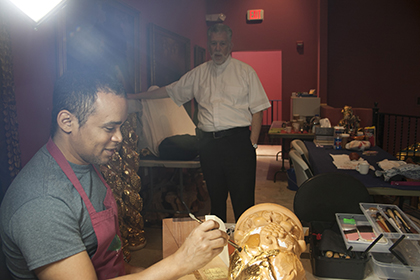
Photographer: ROCIO GRANADOS | LVC
Father José Luis Menéndez, Corpus Christi's pastor, observes Alexis Caser, a gold laminate specialist, place a gold foil in a column of carved cedar wood, at the Merced Church-Museum.
Your huddled masses yearning to breathe free,
The wretched refuse of your teeming shore.
Send these, the homeless, tempest-tost to me,
I lift my lamp beside the golden door!"
"That message has been forgotten, and being an immigrant today is almost a sin. This country is built by immigrants," reminded the priest.
“For us, to finish this church is like offering a gift to this country that allowed us to start our lives again,” continued Father Menéndez, “and to remind Americans that we're not miscreants. We are hard-working people who struggle to enrich this nation.”
When the church of La Merced is completed, the Andean countries will have the best embassy, a church-museum, and it will become the wedding church, Father Menéndez asserted.
And the most valuable thing in the church "is the love with which it is being built,” he added. “The rest is worldly.”
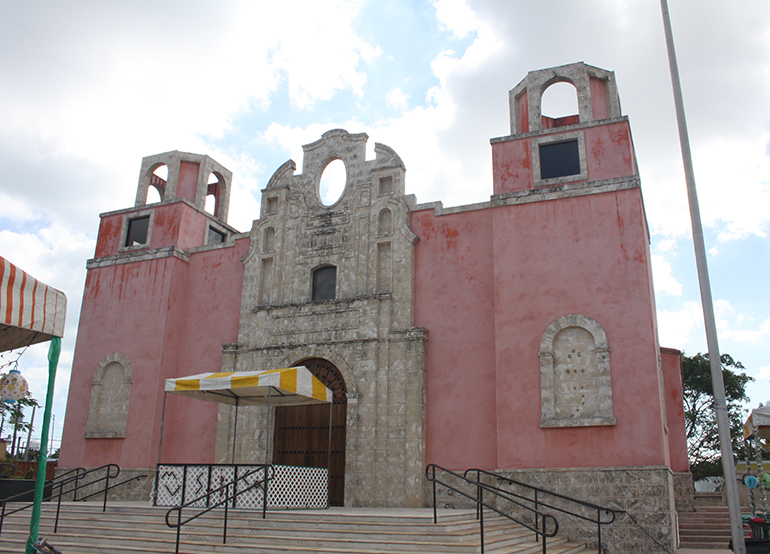
Photographer: ROCIO GRANADOS | LVC
Facade of La Merced Church-Museum, built with the work of all Corpus Christi Church’s communities.
